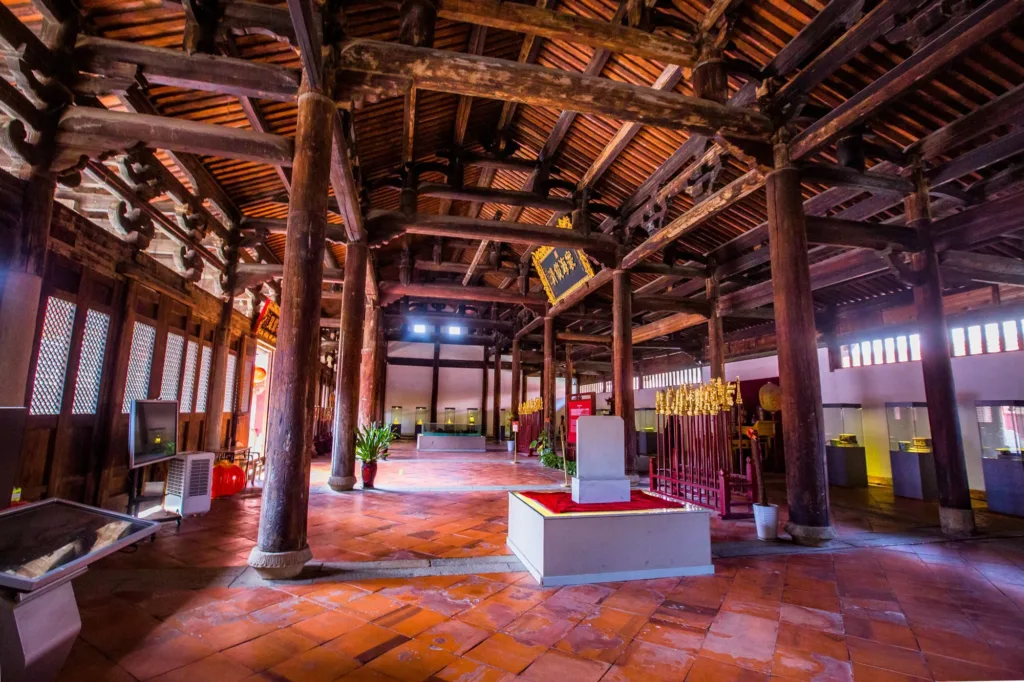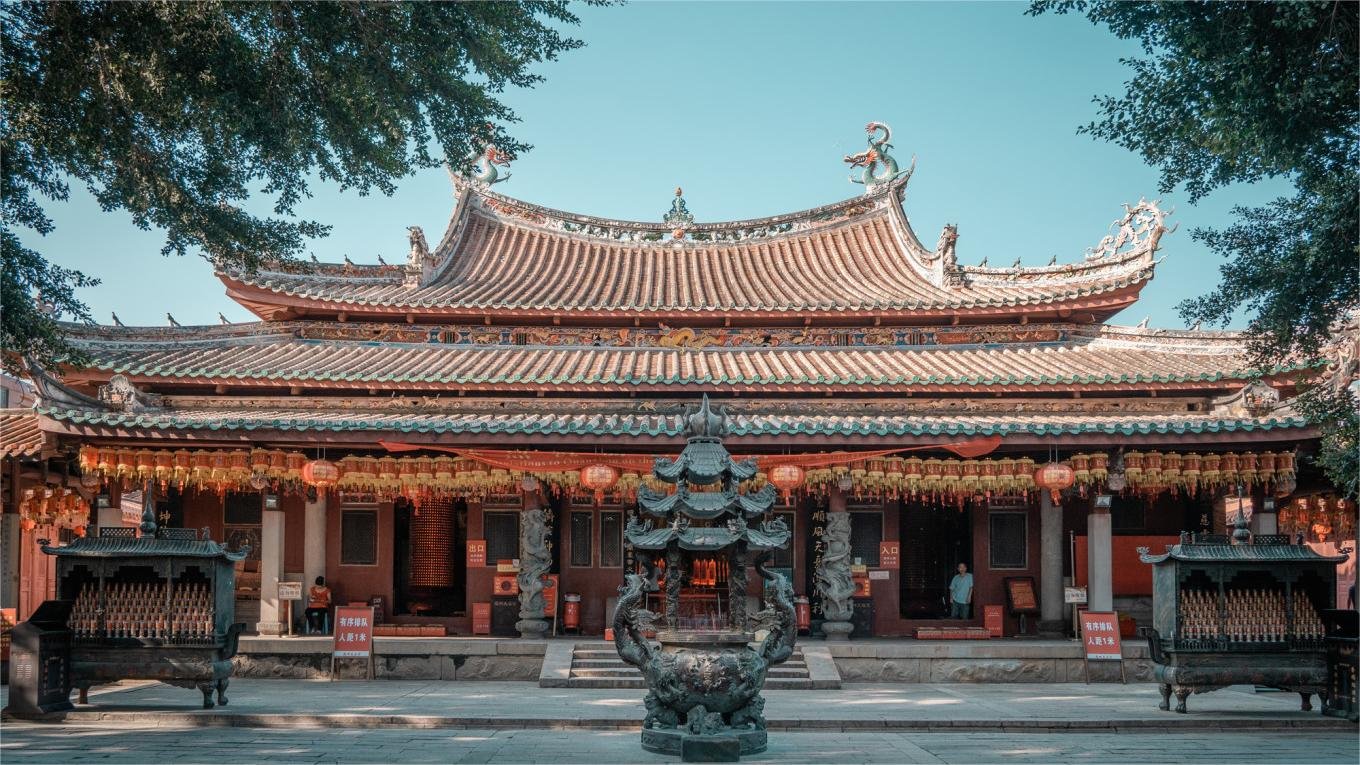Tianhou Palace (天后宫), also known as Mazu Temple or Heavenly Queen Palace, was first established in 1196 during the second year of the Qingyuan era in the Southern Song Dynasty. It is recognized as the oldest and most prestigious Mazu temple in China and abroad. The temple is a significant part of the UNESCO World Heritage Site “Quanzhou: Emporium of the World in Song-Yuan China,” highlighting Quanzhou’s historical importance as a global maritime trade center during the Song and Yuan Dynasties.
Originally named “顺济庙 (Shunji Temple)” after receiving an inscribed plaque from Emperor Huizong of the Song Dynasty, the temple underwent significant changes over the centuries. In 1415, during the Ming Dynasty, Zhang Qian, a high-ranking official, set sail from Quanzhou’s Wujing River on a diplomatic mission to Brunei. Upon his return, he requested the court to renovate the temple extensively, renaming it “天妃宫 (Tianfei Palace)” (Heavenly Princess Palace).
In the 19th year of the Kangxi reign (1680) of the Qing Dynasty, General Shi Lang prepared to invade Taiwan. He reported to the Qing court about the divine assistance received from Mazu, describing it as “divine tide aid” and “contributing to the success of the mission.” In recognition of this, the court conferred the title “Heavenly Empress” upon Mazu, and the temple was renamed “Tianhou Palace” (Heavenly Queen Palace).
The architectural complex of Tianhou Palace preserves elements from the Song Dynasty and timber structures from the Ming and Qing Dynasties. The main buildings are aligned along a north-south central axis and include the Mountain Gate, Opera Stage, East and West Watchtowers, Main Hall, East and West Corridors, Dormitory Hall, East and West Pavilions, Four Cool Pavilions, two Zhai halls, and the Dressing Tower.
Table of Contents
- Basic Information
- Location and Transportation
- Highlights of Tianhou Palace
- Vlog about Quanzhou Tianhou Palace
- Legend of Mazu (Heavenly Empress)
- Other Attractions in Quanzhou Ancient City
Basic Information
| Estimated Length of Tour | 1 hour |
| Ticket Price | Free |
| Opening Hours | 7.00 – 17.00 |
| Telephone Number | 0086-0595-22203731 |
Location and Transportation
Tianhou Palace is located on Tianhou Road, South Gate, Licheng District, Quanzhou City, Fujian Province, China. To get there, you can take bus 2,27, K601, K602, or Ancient City Tourist Line 1 and get off at Licheng Police Station Stop (鲤城公安分局站).
Highlights of Tianhou Palace
Mountain Gate

The original Mountain Gate of Tianhou Palace in Quanzhou, along with the opera stage, was dismantled due to road construction. In March 1990, it was rebuilt with donations from the Lukang Tianhou Temple in Taiwan and its committee members. The new Mountain Gate repurposed elements from the Qing Dynasty’s Jinjiang County School’s horizontal star. The structure spans five bays and features a pagoda-style design with intricately carved and painted wooden brackets. The gate boasts blue stone dragon columns, stone-carved qilins on either side, and chi tiger windows. The double-eaved roof is adorned with ceramic sculptures of eight dragons and two crocodiles, while the ridge ends are styled as phoenix tails, with gracefully curved lines. This overall lavish and majestic structure highlights traditional architectural elegance.
Opera Stage

Connected to the rear eaves of the Mountain Gate and facing the Main Hall, the opera stage of Tianhou Palace is oriented south to north. The stage stands at a height of 1.3 meters, with a width of 6.4 meters and a depth of 5.15 meters, totaling 8 meters in height. The indoor ceiling structure features wooden brackets and a caisson, adorned with colorful paintings and carvings, embodying the distinctive architectural style of southern Fujian. Functionally, the opera stage serves the Main Hall, primarily used during ceremonies dedicated to Mazu, where performances are offered to honor the goddess. Due to its specific ceremonial use, the stage is not frequently utilized, resulting in a lower construction grade and smaller scale.
Tianhou Hall

Tianhou Hall, also known as the Main Hall, is one of the well-preserved Ming and Qing dynasty wooden structures in Tianhou Palace. The hall stands 12 meters tall, with a depth of 25.6 meters and a width of 24.6 meters, covering an area of 635.5 square meters. In front of the hall is a dedicated space for ceremonial activities. Surrounding the hall is a 1-meter-high platform made of granite. Unlike other Tianhou Temples, Quanzhou Tianhou Hall features an additional worship gallery, also known as an eaves gallery, which increases the depth relative to the width and provides more space for worship. The hall’s roof adopts a double-eaved, hip-and-gable style, symbolizing Mazu’s revered status. Tianhou Hall is one of the most ornately decorated buildings in Tianhou Palace, with a roof predominantly adorned with plaster sculptures, mainly of dragons and phoenixes. The beams, columns, and other wooden components are richly painted and carved.
Sleeping Hall

The Sleeping Hall, also known as the Rear Hall, is situated more than 1 meter higher than the Main Hall. It features projecting wings on both sides, used as auxiliary rooms, and left and right Zhai halls. This hall is a large wooden structure from the Ming dynasty, with a gabled roof covering seven bays. The building is 35.1 meters wide, 19.8 meters deep, and approximately 8 meters tall. The wooden beams are robust and simple, with large wooden pillars set on circular granite bases adorned with lotus petal reliefs. In front of the hall’s eaves, there is a pair of sixteen-sided blue stone columns carved during the Yuan dynasty, which were likely placed there during Ming dynasty renovations. These columns are connected to wooden pillars with a couplet inscribed: “Divine power protects the maritime nation, water virtue aligns with heaven and earth.” The front originally had a horizontal plaque inscribed by the famous Ming dynasty calligrapher Zhang Ruitu, reading “后德配天 The virtue of the empress matches the heavens.”
Vlog about Quanzhou Tianhou Palace
Legend of Mazu (Heavenly Empress)
Mazu (妈祖), originally named Lin Mo (林墨), was born in 960 AD during the reign of Emperor Taizu of the Song Dynasty in Qingyuan Prefecture, Putian County (present-day Putian, Fujian Province). She was born on the 23rd day of the third lunar month. Her father, Lin Yuan, and mother, Madam Wang, were known for their benevolence and charity. Despite having one son and five daughters, they desired another son to ensure the continuation of their family line and prayed to the bodhisattva Guanyin for this blessing.
Shortly after, Madam Wang became pregnant. During the birth of Lin Mo, Madam Wang saw a brilliant light shining into her room from the northwest, accompanied by a fragrant aroma that lingered for a long time. As Lin Mo grew up, she resolved to dedicate her life to doing good deeds and helping others. She vowed never to marry and instead devoted herself to studying medicine and assisting people in need. Her compassionate nature and willingness to help others earned her great respect in her community. She provided medical care, advised villagers on how to avoid disasters, and offered comfort and aid to those in distress.
During a severe epidemic in the Putian area, Lin Mo worked tirelessly to treat the sick and save lives, earning a reputation for her miraculous healing abilities. In 987 AD, on the Double Ninth Festival, Lin Mo’s father and brothers set out on a voyage. As they encountered a violent storm with strong winds and high waves, their boat was in peril. Sensing their danger, Lin Mo traveled to the scene to rescue them. She managed to save her father, but tragically, her brother and she herself perished in the effort.
Following her death, Lin Mo was revered as a sea goddess due to her benevolent deeds and miraculous powers. Fishermen and coastal communities built a temple in her honor at the site of her ascension in Meizhou, Putian, which became the ancestral temple of the over 5,000 Mazu temples worldwide. Fishermen regularly prayed and offered sacrifices to Mazu, seeking her continued protection and blessings.








